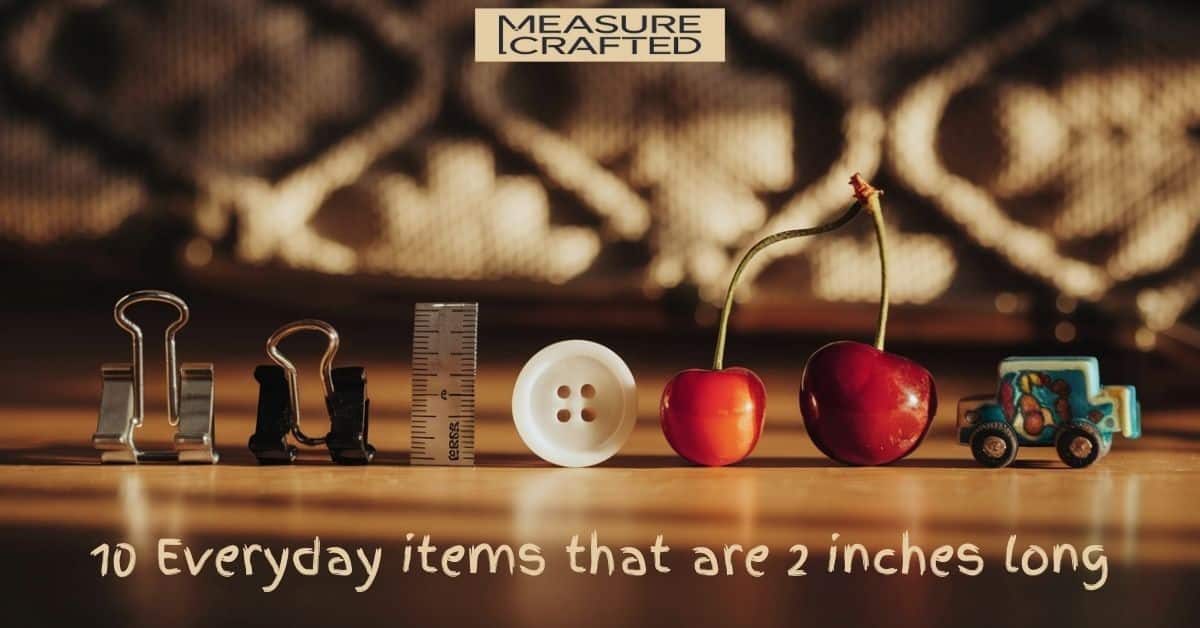As someone who works frequently in DIY crafting and projects, I’ve discovered that knowing basic measurements can be beneficial.
Today, let’s take a look at the things we use every day, but aren’t aware of – objects that are just 2 inches.
When you’re working on a house project or helping children with their crafts, having the basic references to these topics can be surprisingly helpful.
Table of Contents
How Big is 2 Inches?
Based on my experience of working with measurements daily, I’ve discovered that 2 inches is approximately 5.08 centimeters. That’s 50.8 millimeters. For quick conversions, it’s about 0.167 feet. The common measurement is all over our lives, from the things that you place on your desk to the gadgets you carry around in your pockets. Consider the size of a normal Post-it notepad or the size of your thumb. These daily references can help us comprehend this important measurement.
How Big Is 2 Inches On Your Hand?
Your hand is an amazingly accurate natural measuring instrument. For the majority of adults, 2 inches is equivalent to the length that your thumb is from the knuckle up to the end, or the length of two fingers pressed together (typically your middle and index fingers).
Although hand sizes differ between people, these rough approximations are useful for those who need an instant reference to size. When you understand what 2 inches means concerning the measurements of your hands, you’ll always have a trustworthy measuring instrument in your bag.
Typical Objects That Measure 2 Inches
Finding everyday objects that measure just 2 inches is extremely useful when you require quick reference for measurement.
Let’s look at 11 items you’ll likely encounter frequently that could be used as reliable 2-inch measuring instruments.
- Two US Quarters
- A Business Card
- Height of Two Hockey Pucks
- Length of Two Small Paperclips
- Two Pen Caps
- A Pool Ball
- The height of AA batteries
- The length of the eraser
- 3.5x Length of an Aspirin
- Height of an Artificial Christmas Tree
- The Length of A Matchstick
Two US Quarters
Imagine those sparkling quarters that are bouncing around in your pockets These aren’t just for vending machines or parking meters.
If placed side-by-side when placed side by side, two US quarters form an exact 2-inch measurement of 2. Each quarter is sized with an overall size in the range of 0.955 inches, meaning that two quarters combined measure roughly 1.91 inches, which is very close to our goal measurement.
The small difference isn’t evident in everyday life, which makes quarters an extremely practical tool for measuring.
Their standard dimension, regulated by the U.S. Mint, ensures uniformity throughout all quarters issued since 193.2. They are among the most reliable, impromptu measurement tools you’ll discover within your pocket.
A Business Card
That tiny piece of cardstock that you exchange at networking events has more value than contact details.
The standard business cards that are used in North America are designed to measure exactly 2 inches in height, while their width can reach 3.5 inches.
The standardization of these makes them excellent informal rulers to measure quickly. The cardstock material is rigid and holds its shape very well, unlike paper, which can tear or bend.
Professional printers and designers rely on these exact measurements to produce thousands of business cards each year and ensure a high degree of consistency across various brands and designs. If you ever need to measure something that is around 2 inches in length, the wallet could contain the right measure.
Height of Two Hockey Pucks
Place two ice hockey pucks over the other. You’ll have the perfect 2-inch measurement.
Every regulation NHL puck measures exactly one inch tall, making this combination accurate and reliable. The vulcanized rubber discs are produced to the highest standards not only for size but also for size and weight, which ensures consistency in the game on skating ice.
The long-lasting nature of hockey pucks makes them great reference points for measuring, since they keep their shape after prolonged use.
Although you may not be carrying hockey pucks on your person all the time, this measurement data shows how sports equipment usually conforms to certain dimensional standards.
Length of Two Small Paperclips
Small paperclips, the humble desk buddies, usually weigh around 1 inch in size.
Simply place two small paperclips from end to end, and you’ve created a convenient 2-inch measuring instrument. The benefit of using paperclips is their ubiquity – almost every office, school or even your home has a paperclip hidden away.
The consistent process of manufacturing guarantees the same size across all brands. While there could be a few minor variations among manufacturers, the small paperclip has remained remarkably consistent in its dimensions since its introduction in the 19th century, thereby making it a reliable measuring tool that has stood the test of time.
Two Pen Caps
The typical cap for a pen, which is designed to protect the writing tips and keep the ink from drying, generally has a 1-inch length.
If you match two caps of traditional ballpoint pens from end to end, they give you a surprisingly precise 2-inch measurement of 2 inches.
This kind of knowledge can be valuable in school or office environments where pens are always in reach.
Different pen makers use similar lengths of caps for ergonomic reasons; however, the quality or special pens may differ little.
The construction of plastic in most caps is designed to ensure they keep their shape as well as size, which makes them useful measuring tools in the event of need.
A Pool Ball
Standard Billiard balls. These vibrant balls that are bouncing around pool tables across the world measure precisely 2.25 millimeters in size. They are less than 2 inches. They’re an ideal reference point for measuring 2-inch dimensions.
The pool balls are made according to very precise specifications, since even tiny differences in size could impact the way players play.
The solid construction and flawless shape make them ideal for measuring diameter.
While the quarter-inch differences mean they’re not the best for exact measurements, their standard dimensions across all manufacturers are a good way to ensure estimates.
Height of AA Battery
The AA battery that is commonly used, which powers everything from toys to remotes and toys, is a standard size of nearly two inches (50.5 millimeters).
The requirement for uniform size set by international standards bodies makes sure that these batteries function consistently across various brands and devices.
The metal casing is an extremely reliable measurement reference that doesn’t change or deform over time. Their cylindrical design makes them ideal for measuring circular openings or curves on surfaces.
The ubiquitous use of AA batteries within households across the globe makes them one of the most easily accessible 2-inch measurement sources accessible.
Length of an Eraser
The most common pink rubber eraser, which is a common item in school supplies as well as office desks, measures about 2 inches long.
The erasers have the same dimensions among different manufacturers because of practical reasons – they must be large enough to comfortably hold, but compact enough to store easily.
Their rectangular shape of the erasers makes them efficient for determining sharp lines and edges. Although erasers gradually become less effective but new models provide a solid 2-inch reference.
The softness of their material means that they are able to compress slightly, which is why they’re a good choice for approximate, not precise measurements.
3.5x Length of an Aspirin
Aspirin tablets are standard and measure around 0.57 inches in width. Take three and one-half aspirin tablets and you’ll be able to measure almost 2 inches.
This may appear to be an odd measurement tool; however, it is a great example of how even the smallest of items are measured in a standard way.
Pharmaceutical companies adhere to strict control of size to ensure consistent dosage and easy swallowing, which makes aspirin tablets remarkably homogeneous.
While it’s not the best measurement tool, this shows how exact manufacturing standards are even for the smallest of items that we use daily.
Height of an Artificial Christmas Tree Base
The base of a variety of artificial Christmas trees is approximately 2 inches tall.
The size is selected by the manufacturers to ensure security while being unobtrusive. The sturdy base construction makes them reliable reference points that can maintain their dimensions every year.
Although you may only be able to use this measuring tool at the time of the holidays, it’s an excellent source of information when you’re setting up decorations or weighing nearby objects.
The uniformity of sizes across various brands is a solid source of information, but it’s important to remember that specialty or premium trees could have different dimensions for the base.
The Length of A Matchstick
A standard kitchen matchstick is 2 inches from end to end. This length has been adapted through the years of manufacturing to ensure the ideal combination of usability and safety.
Match manufacturers around the world have similar dimensions, which makes them astonishingly uniform measuring instruments. The wooden construction guarantees that the length remains constant until the match is utilized.
While matches may not be the first option to measure tools, their standard dimensions make them a useful reference for measuring devices when none are readily available.
FAQ
What is the equivalent of 2 centimeters? inches?
Two inches is exactly 5.08 centimeters. I often use this conversion when working using international measurements. It is particularly helpful when trying to follow recipes or patterns for crafts from countries that utilize the metric system.
What is the equivalent of 2 inches and feet?
Two inches is equivalent to 0.167 feet. While it may seem like an odd however, it can be very useful for construction projects or home renovations, which are usually measured in feet.
What is the millimeter equivalent of 2 inches?
In millimeters, 2 inches equals 50.8 millimeters. This exact measurement is essential for electronics work or complex craft projects where millimeter precision is crucial.









